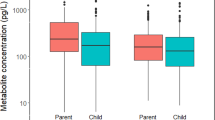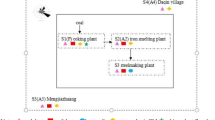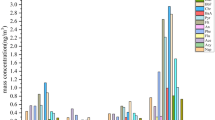Abstract
Personal exposures to carcinogenic polycyclic aromatic hydrocarbons (c-PAHs) bound to airborne particulate matter ⩽2.5 μm (PM2.5) were measured in the context of a large-scale molecular epidemiological study in order to identify the impacts of air pollution on human health. Sampling was carried out in three industrial cities in the Czech Republic: Ostrava, Karvina and Havirov. The city of Prague, exhibiting much lower industrial air pollution but a high level of traffic, served as a control. The first monitoring campaigns were held in winter and were repeated in the summer of 2009. The active personal monitors PV 1.7 for PM2.5-bound c-PAHs were used. Non-smoking city policemen from Prague, Karvina and Havirov, and office workers from Ostrava, participated in the study. All participants completed a personal questionnaire and a time-location-activity diary. The average personal winter exposure to c-PAHs (sum of the eight PAHs—benz[a]anthracene, benzo[a]pyrene, benzo[b]fluoranthene, benzo[g,h,i]perylene, benzo[k]fluoranthene, chrysene, dibenz[a,h]anthracene and indeno[1,2,3-c,d]pyrene) was highest in Karvina, 39.1, followed by Ostrava at 15.1 and Prague at 4.3 ng/m3. The winter levels were significantly higher than the summer values (P<0.001): 4.3 in Karvina, 3.0 in Ostrava, 1.6 in Havirov and 1.0 ng/m3 in Prague. The average personal benzo[a]pyrene winter/summer exposures were: 6.9/0.6 in Karvina, 2.5/0.4 in Ostrava, 0.8/0.1 in Prague and 0.2 ng/m3 in summer in Havirov. In this study, we examined personal exposure to c-PAHs and tested it for associations with potential predictor variables collected from questionnaires, addressing life style factors and day-to-day activities. We found outdoor concentration, environmental tobacco smoke exposure, home heating fuel of coal, wood or gas, frequency of exhaust fan use, cooking and commuting by a car to be the main determinants of personal exposure.
This is a preview of subscription content, access via your institution
Access options
Subscribe to this journal
Receive 6 print issues and online access
$259.00 per year
only $43.17 per issue
Buy this article
- Purchase on Springer Link
- Instant access to full article PDF
Prices may be subject to local taxes which are calculated during checkout

Similar content being viewed by others
References
Brunekreef B, Holgate ST . Air pollution and health. Lancet 2002; 360 (9341): 1233–1242.
Brunekreef B, Beelen R, Hoek G, Schouten L, Bausch-Goldbohm S, Fischer P et al Effects of long-term exposure to traffic-related air pollution on respiratory and cardiovascular mortality in the Netherlands: the NLCS-AIR study. Res Rep Health Eff Inst 2009: ((139): 5–71 discussion 73–89.
Künzli N, Tager IB . Air pollution: from lung to heart. Swiss Med Wkly 2005; 135 (47-48): 697–702.
Peng RD, Bell ML, Geyh AS, McDermott A, Zeger SL, Samet JM et al Emergency admissions for cardiovascular and respiratory diseases and the chemical composition of fine particle air pollution. Environ Health Perspect 2009; 117 (6): 957–963.
Pope CA, Burnett RT, Thun MJ, Calle EE, Krewski D, Ito K et al Lung cancer, cardiopulmonary mortality, and long-term exposure to fine particulate air pollution. JAMA 2002; 287 (9): 1132–1141.
Pope CA, Burnett RT, Thurston GD, Thun MJ, Calle EE, Krewski D et al Cardiovascular mortality and long-term exposure to particulate air pollution: epidemiological evidence of general pathophysiological pathways of disease. Circulation 2004; 109 (1): 71–77.
Sorensen M, Autrup H, Moller P, Hertel O, Jensen SS, Vinzents P et al Linking exposure to environmental pollutants with biological effects. Mutat Res 2003; 544 (2-3): 255–271.
Sram RJ, Binkova B, Dejmek J, Bobak M . Ambient air pollution and pregnancy outcomes: a review of the literature. Environ Health Perspect 2005; 113 (4): 375–382.
CENIA, Czech Environmental Information Agency 2009 Available at http://www.cenia.cz/web/www/web-pub2.nsf/$pid/CENMSFYDBW7F/$FILE/porovnani_kraju.pdf . (Accessed 20 June 2010).
Binkova B, Vesely D, Vesela D, Jelinek R, Sram RJ . Genotoxicity and embryotoxicity of urban air particulate matter collected during winter and summer period in two different districts of the Czech Republic. Mutat Res 1999; 440 (1): 45–58.
Sugita K, Goto S, Endo O, Nakajima D, Yajima H, Ishii T . Particle size effects on the deposition ratios of airborne particles in the respiratory tract. J Health Sci 2004; 50 (2): 185–188.
Pope CA, Muhlestein JB, May HT, Renlund DG, Anderson JL, Horne BD . Ischemic heart disease events triggered by short-term exposure to fine particulate air pollution. Circulation 2006; 114 (23): 2443–2448.
Lewtas J . Air pollution combustion emissions: characterisation of causative agents and mechanisms associated with cancer, reproductive and cardiovascular effects. Mutat Res 2007; 636 (1-3): 95–133.
Nishioka MG, Lewtas J . Quantification of nitro- and hydroxylated nitro-aromatic/polycyclic aromatic hydrocarbons in selected ambient air daytime winter samples. Atmos Environ 1992; 26 (11): 2077–2087.
Topinka J, Rossner P, Milcova A, Schmuczerova J, Svecova V, Sram RJ . DNA adducts and oxidative DNA damage induced by organic extracts from PM2.5 in an acellular assay. Toxicol Lett 2011; 202 (3): 186–192.
Binkova B, Sram RJ . The genotoxic effect of carcinogenic PAHs, their artificial and environmental mixtures (EOM) on human diploid lung fibroblasts. Mutat Res 2004; 547: 109–121.
Brandt HC, Watson WP . Monitoring human occupational and environmental exposures to polycyclic aromatic compounds. Ann Occup Hyg 2003; 47 (5): 349–378.
International Agency for Research on Cancer (IARC) Monographs on the Evaluation of Carcinogenic Risks to Humans 2009 Available at http://monographs.iarc.fr/ENG/Classification/index.php.
Monn C, Fuchs A, Högger D, Junker M, Kogelschatz D, Roth N et al Particulate matter less than 10 microns (PM10) and fine particles less than 2.5 microns (PM2.5): relationships between indoor, outdoor and personal concentrations. Sci Total Environ 1997; 208 (1-2): 15–21.
Adgate J, Eberly LE, Stroebel C, Pellizzari ED, Sexton K . Personal, indoor, and outdoor VOC exposures in a probability sample of children. J Expo Anal Environ Epidemiol 2004; 14: S4–S13.
Jedrychowski W, Pac A, Choi H, Jacek R, Sochacka-Tatara E, Dumyahn TS et al Personal exposure to fine particles and benzo[a]pyrene. Relation with indoor and outdoor concentrations of these pollutants in Kraków. Int J Occup Med Environ Health 2007; 20 (4): 339–348.
Devi JJ, Gupta T, Tripathi SN, Ujinwal KK . Assessment of personal exposure to inhalable indoor and outdoor particulate matter for student residents of an academic campus (IIT-Kanpur). Inhal Toxicol 2009; 21 (14): 1208–1222.
Gerharz LE, Kruger A, Klemm O . Applying indoor and outdoor modeling techniques to estimate individual exposure to PM2.5 from personal GPS profiles and diaries: a pilot study. Sci Total Environ 2009; 407 (18): 5184–5193.
Czech Statistical Office 2010 Available at http://www.czso.cz/eng/redakce.nsf/i/home . (Accessed 10 June 2010.
CENIA. Czech Environmental Information Agency. State of the environment by regions in the Czech Republic in 2008. CENIA. Ministry of Environment of the Czech Republic, Prague, CZ. 2009.
Langone JJ, Van Vunakis H . Radioimmunoassay of nicotine, cotinine, and gamma-(3-pyridyl)-gamma-oxo-N-methylbutyramide. Methods Enzymol 1982; 84: 628–640.
Binkova B, Lewtas J, Miskova I, Lenicek J, Sram R . DNA adducts and personal air monitoring of carcinogenic polycyclic aromatic hydrocarbons in an environmentally exposed population. Carcinogenesis 1995; 16 (5): 1037–1046.
Williams RW, Watts RR, Stevens RK, Stone CL, Lewtas J . Evaluation of a personal air sampler for twenty-four hour collection of fine particles and semivolatile organics. J Expo Anal Environ Epidemiol 1999; 9 (2): 158–166.
Peluso M, Merlo F, Munnia A, Valerio F, Perrotta A, Puntoni R et al 32 P-postlabeling detection of aromatic adducts in the white blood cell DNA of nonsmoking police officers. Cancer Epidemiol Biomarkers Prev 1998; 7 (1): 3–11.
Taioli E, Sram RJ, Garte S, Kalina I, Popov TA, Farmer PB . Effects of polycyclic aromatic hydrocarbons (PAHs) in environmental pollution on exogenous and oxidative DNA damage (EXPAH project): description of the population under study. Mutat Res 2007; 620 (1-2): 1–6.
Topinka J, Sevastyanova O, Binkova B, Chvatalova I, Milcova A, Lnenickova Z et al Biomarkers of air pollution exposure – A study of policemen in Prague. Mutat Res 2007; 624 (1-2): 9–17.
DIRECTIVE 2004 107/EC OF THE EUROPEAN PARLIAMENT AND OF THE COUNCIL, relating to arsenic, cadmium, mercury, nickel and polycyclic aromatic hydrocarbons in ambient air, Official Journal of the European Union, L 23/3, 26.1.2005.
Hertz-Picciotto I, Baker RJ, Yap PS, Dostal M, Joad JP, Lipsett M et al Early childhood lower respiratory illness and air pollution. Environ Health Perspect 2007; 115 (10): 1510–1518.
Rossner P, Rossnerova A, Sram RJ . Oxidative stress and chromosomal aberrations in an environmentally exposed population. Mutat Res 2010; 707 (1-2): 34–41.
Sram RJ, Beskid O, Binkova B, Chvatalova I, Lnenickova Z, Milcova A et al Chromosomal aberrations in environmentally exposed population in relation to metabolic and DNA repair genes polymorphisms. Mutat Res 2007; 620 (1-2): 22–33.
Svecova V, Rossner P, Dostal M, Topinka J, Solansky I, Sram RJ . Urinary 8-oxodeoxyguanosine levels in children exposed to air pollutants. Mutat Res 2009; 662 (1-2): 37–43.
Tonne CC, Whyatt RM, Camann DE, Perera FP, Kinney PL . Predictors of personal polycyclic aromatic hydrocarbon exposures among pregnant minority women in New York City. Environ Health Perspect 2004; 112 (6): 754–759.
Zmirou D, Masclet P, Boudet C, Dor F, Dechenaux J . Personal exposure to atmospheric polycyclic aromatic hydrocarbons in a general adult population and lung cancer risk assessment. J Occup Environ Med 2000; 42 (2): 121–126.
Piccardo MT, Stella A, Redaelli A, Balducci D, Coradeghini R, Minoia C et al Personal daily exposures to benzo(a)pyrene of taxi drivers in Genoa, Italy. Sci Total Environ 2004; 330 (1-3): 39–45.
Choi H, Perera F, Pac A, Wang L, Flak E, Mroz E et al Estimating individual-level exposure to airborne polycyclic aromatic hydrocarbons throughout the gestational period based on personal, indoor, and outdoor monitoring. Environ Health Perspect 2008; 116 (11): 1509–1518.
Acknowledgements
The study was supported by the Ministry of the Environment of the Czech Republic (CZ:MZP CR:SP/1b3/8/08) and the Ministry of Education, Youth and Sports of the Czech Republic (CZ:MSMT CR:2B08005). We are very thankful to the willingness of all the study participants, who contributed tremendously to the success of this project. We also specially thank the cooperating institutions and personnel who helped with the coordination of the monitoring campaigns and provided critical facilities for realizing the campaigns: the Regional Authority of the Moravian-Silesian Region in Ostrava and the Municipal Police in Karvina, Havirov and Prague. We thank Mr. James Dutt for editing the manuscript.
Author information
Authors and Affiliations
Corresponding author
Ethics declarations
Competing interests
The authors declare no conflict of interest.
Additional information
Supplementary Information accompanies the paper on the Journal of Exposure Science and Environmental Epidemiology website
Supplementary information
Rights and permissions
About this article
Cite this article
Svecova, V., Topinka, J., Solansky, I. et al. Personal exposure to carcinogenic polycyclic aromatic hydrocarbons in the Czech Republic. J Expo Sci Environ Epidemiol 23, 350–355 (2013). https://doi.org/10.1038/jes.2012.110
Received:
Revised:
Accepted:
Published:
Issue Date:
DOI: https://doi.org/10.1038/jes.2012.110
Keywords
This article is cited by
-
Characterizing the external exposome using passive samplers—comparative assessment of chemical exposures using different wearable form factors
Journal of Exposure Science & Environmental Epidemiology (2023)
-
A novel strategy for the determination of polycyclic aromatic hydrocarbon monohydroxylated metabolites in urine using ultra-high-performance liquid chromatography with tandem mass spectrometry
Analytical and Bioanalytical Chemistry (2016)
-
Toxic elements and persistent organic pollutants derived from industrial emissions in agricultural soils of the Northern Czech Republic
Journal of Soils and Sediments (2015)
-
Comparison of child morbidity in regions of Ostrava, Czech Republic, with different degrees of pollution: a retrospective cohort study
Environmental Health (2013)
-
Personal exposure to volatile organic compounds in the Czech Republic
Journal of Exposure Science & Environmental Epidemiology (2012)



